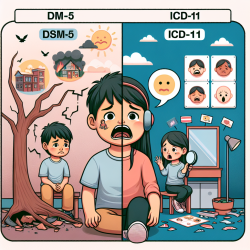Understanding PTSD through Symptom Networks: A New Frontier in Therapy
In the realm of mental health, understanding the intricacies of disorders like posttraumatic stress disorder (PTSD) is crucial for effective treatment. A recent study, An exploration of the DSM-5 posttraumatic stress disorder symptom latent variable network, offers groundbreaking insights into how PTSD symptoms interconnect, providing a fresh perspective for practitioners, especially those involved in online therapy services like TinyEYE.
The Study: Bridging Latent Variables and Networks
The study explores the latent network model (LNM), which combines the latent variable model and the network model to offer a comprehensive view of PTSD symptoms. This approach provides a dual perspective, considering both the individual symptom dimensions and their interconnections.
Conducted on survivors of the 2008 Wenchuan earthquake and validated with a sample of children and adolescents, the study highlights the importance of considering both symptom dimensions and their associations in clinical practice.
Key Findings and Implications for Practitioners
- Centrality of Externalizing Behaviors: The study identified externalizing behaviors as having the highest centrality in the PTSD symptom network. This suggests that interventions targeting these behaviors could significantly impact the overall symptom network.
- Intrusion and Avoidance: A strong connection between intrusion and avoidance symptoms was observed, reinforcing the importance of addressing these core symptoms in therapy.
- Negative Edge between Anxious Arousal and Negative Affect: This finding suggests that externalizing behaviors may arise from both anxious arousal and negative affect, highlighting potential areas for targeted intervention.
Practical Applications in Online Therapy
For practitioners at TinyEYE and similar platforms, these insights can inform therapy strategies, particularly for children who may exhibit PTSD symptoms differently than adults. By focusing on symptom dimensions with high centrality, therapists can design more effective interventions that address the root of the disorder.
Moreover, understanding the interplay between symptoms can guide the development of personalized therapy plans, ensuring that each child's unique needs are met.
Encouraging Further Research
While this study provides a robust framework for understanding PTSD symptoms, it also opens the door for further research. Practitioners are encouraged to explore how these findings can be integrated into existing therapy models and to investigate the applicability of the latent network model across different cultural contexts and trauma types.
To read the original research paper, please follow this link: An exploration of the DSM-5 posttraumatic stress disorder symptom latent variable network.










